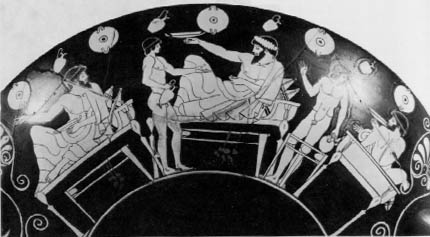|
PEDERASTY
|
- "love of boys"; refers to an asymmetrical and
hierarchical relation between an adult man and a
pubescent boy; ideally the relationship, once
established, continued for a period of time during which
the older man conferred on the boy the benefits of his
knowledge, wisdom, and experience in the polis and
the boy granted his older lover sexual favors; in
other words, the relationship was seen as part of the
education and initiation of youths into adult male
society. (Recall from Aristophanes' Clouds the
interest of Better Argument in young boys genitalia.)
- the Greeks conceived of the asymmetricality not in
terms of the gender of the partners (male-female), but in
terms of active and passive roles; hence pederasty refers
to an asymmetrical relation between an older and active
partner(the lover/erastes;) and a younger, passive
partner (the beloved/eromenos);
- adult males were expected to always be the
active partner (i.e., the one who penetrates) regardless
of the gender of their partner; sex with a passive (i.e.,
penetrated) partner of either gender was generally
socially acceptable (excepting, of course, with certain
protected Athenian women such as citizens' wives and
unmarried daughters);
- the relationship between the erastes and
eromenos was frequently valorized as contributing
to the moral and intellectual development of the youth
(e.g., Pausanias in the Symposium); it was also
demonized by some writers as aristocratic excess;
- a pederastic relationship was ordinarily
terminated when the youth came to full maturity (could
sport a beard), at which point he could become the active
partner in a relationship with a younger male. The
evidence about whether married men continued to pursue
relations with boys is mixed, but it is very possible
that they did so. (Men married in classical Athens at
about 30 years of age)
- there is little or no evidence from Greek
antiquity for a concept of homosexuality as 'sexual
orientation'; the norm was something like serial
bisexuality;
- Athenian society generally encouraged the
erastes to pursue a boy to love,
courting him with gifts, etc.;
but nonetheless expected the boy (and his family) to
resist the relationship; the youths were not expected to
enjoy the sexual relation but to finally give sexual
favors in return for the benefits of the mentoring
relationship;
- copulation with citizen boys was usually
intercrural, that is,
penetration was between the boys thighs, not anal;
- religious festivals, the gymnasium, and
symposia were popular places to
pursue youths;
- this is not to say that pederasty was the only
expression of same-sex relations in ancient Greece;
indeed Pausanias--whom Plato (in the Symposium)
has defend long-term same-sex partnerships between
adults--was known to have had a lengthy relationship with
Agathon. Such relations were, however, suspect at best
because of the passivity that would necessarily be
involved.
|

